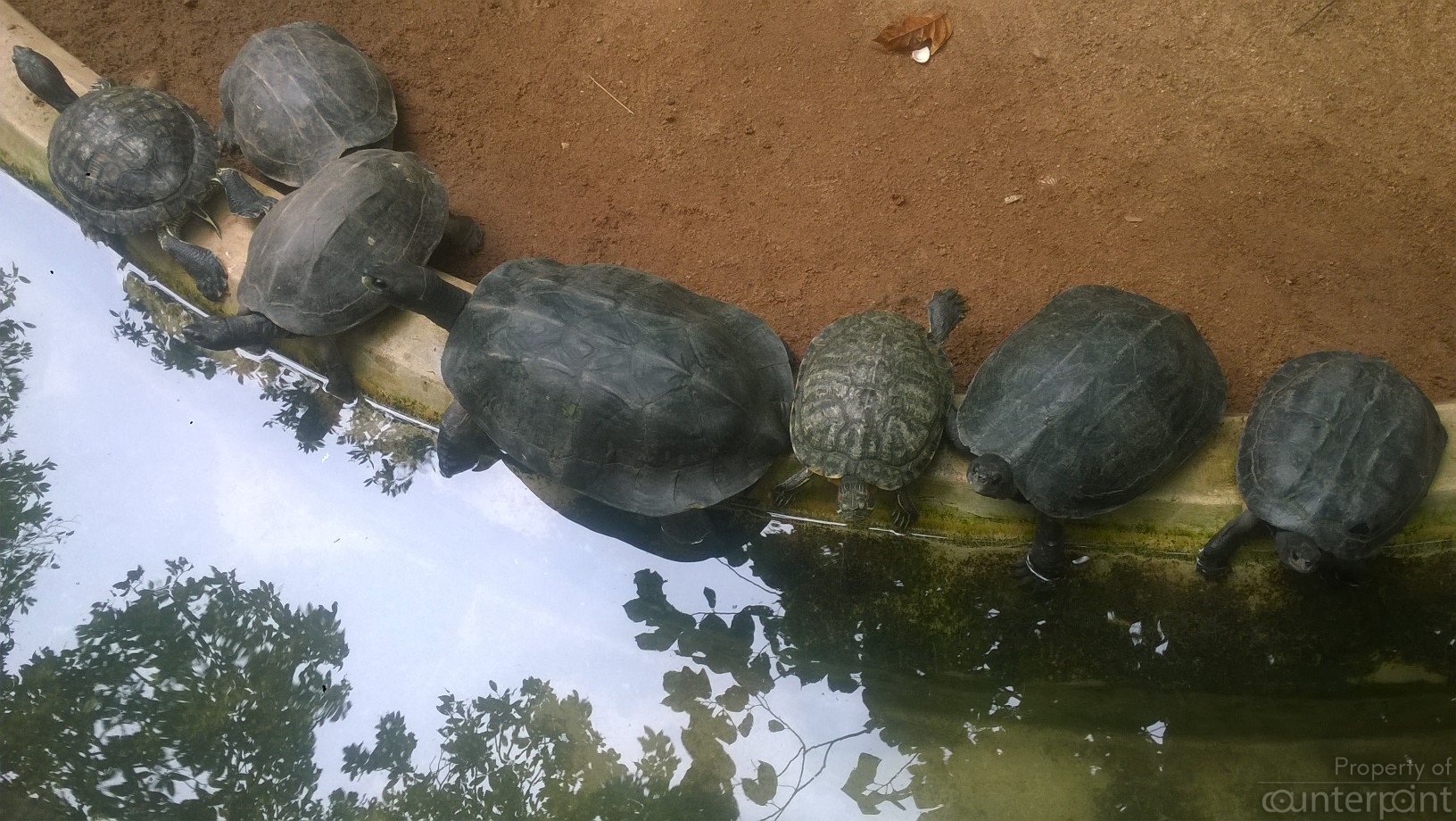Sri Lanka is renowned for her rich biodiversity; however, there is no systematic monitoring implemented regionally or countrywide. Without certain details, conservation assessments of Sri Lankan chelonians or terrapins are liable to mistakes.
Researcher Sameera Suranjan Karunarathna believes that countrywide surveys of chelonians are of critical importance. He hopes his recent study would be a step towards regional assessments that later could be cumulated towards countrywide surveys.
The sampling protocol and habitat assessment methods may provide a baseline foundation for similar other regional surveys. He has stressed the need to survey habitats both inside and outside current protected area network; surveys outside protected areas will reveal “chelonian hotspots” (i.e., diversity-rich habitats that are under threat) that needs special attention, especially in terms of land acquisition and habitat restoration.
Speaking to Counterpoint, he recommends that least altered and rural rivers shawls be used as dispersal corridors to maintain terrapin metapopulation dynamics. Critical terrapin habitats confer many ecosystem services- flood mitigation, water purification, groundwater recharge, and freshwater fish conservation- therefore, implementing multipurpose wetland and riverine biodiversity conservation plans might help convergence of many natural resource managers.
Terrapins are charismatic flagship species, thus are symbolic for awareness programmes, conservation education, and generating conservation dollars. Effective terrapin conservation requires large extents of forested landscapes, embedded with multiple wetlands and other aquatic habitats; therefore, terrapins can be considered an umbrella species whose protection ensures conservation of a multitude of imperiled habitats and biotic communities.
Intensive, multi-seasonal continuous population monitoring that accounts for imperfect detection is required to ascertain the true population size of this species, especially in locations where this species was historically detected but not found in the current study. Detailed investigations on their breeding biology (mating frequency, mating systems, mate choice, and reproductive success) can substantially contribute to conservation efforts.
The Sri Lanka flap-shelled terrapin (Lissemys ceylonensis) occurs in a variety of aquatic habitats, ranging from rivers and streams to reservoirs, marshes, ponds, lakes, and even salt marshes, rice fields, gutters, and canals in urban areas. This species appears to tolerate saltwater conditions as well, as it is common in brackish water lagoons in Panadura, Batticaloa, Negombo and Panama. It is often abundant in irrigation canals and tanks, and paddy fields with stagnant water. Terrapin seems to prefer relatively shallow waters, which may be devoid of aquatic vegetation and they may spend a long period shallowly buried in the mud bottoms.
Overland movements occur in response to either drought conditions, or increased water depth during the rainy season. In the latter instance, terrapins move overland into shallow pools; when these dry up, they move back into the larger, permanent sites. Terrapins move overland (referred as active period), burrow, and aestivate when shallow ponds and lakes dry up in August. The species is an opportunistic omnivore; food items include adult frogs, tadpoles, fish, crustaceans, mollusks, earthworms, insects, carrion, and water plants (Deraniyagala, 1930). Throughout tropical wet climates, these terrapins remain active year-round; their reproduction season spans from August to December. Based on available literature these animals are more active in the night.
The Flat-black terrapin (M. t. thermalis) can tolerate human-modified ecosystems such as open areas of rice paddies, thus making it a widespread terrapin (de Silva, 1999). In Gampaha and Colombo districts, the species is found in man-made water holes, as well as in slow-moving streams within sub- forested habitats. Although it is essentially a species of stagnant water bodies, it also occurs in running water bodies, such as streams and rivers. During the dry season, it may be encountered a long distance from water.
In Sri Lanka, juveniles have been found in the isolated channels close to mountain streams, as well as marshes with brackish water influence. The species shows a crepuscular to nocturnal lifestyle, with individuals seen foraging after dark along the edges of water bodies in the area of Attanagaluoya, Gampaha. In other parts of its range, after foraging the turtles may lie near the edge of the water bodies, spending the entire or most of the night outside water. As a defense response when picked up, terrapins defecate copiously, in the manner of land tortoises, and sometimes exude a vile-smelling fluid from the inguinal pores.
Available information from multiple surveys recognized the following threats for the species: loss of core (aquatic) and peripheral (wetlands and riparian terrestrial) habitats and landscape impermeability given modifications of natural land cover, including dredging and draining wetlands ; degradation of habitat quality due to alien invasive species and pollution due to both point-source (industrial effluvia, sewage and municipal outlets) and nonpoint-source pollution (garbage disposal, soil erosion, and agrochemical runoff); hydrologic modifications such as channelization, diversions, and over-extraction of water; localized consumptive overexploitation as a protein source and purported medicinal value; and impuissance of state policies and poor governance outside the protected area network.
These threats act synergistically and thus could have compounding adversities on terrapin communities of Sri Lanka that depend upon multiple aquatic, wetland, and terrestrial habitats for refuge, foraging, nesting, nursing the young, for many other life history functions, and potential impact of invasive red-eared slider turtle (Trachemys scripta).
Road mortality and subsidized predation on eggs and hatchlings by domesticated dogs and cats as well as human commensals such as feral pigs and village crows, are also some notable threats. Sand and gem mining, algal blooms due to eutrophication, and impacts originating from climate change, such as increased intensity and frequency of droughts, have been documented in Sri Lanka; such environmental impacts could exacerbate the current imperilment. Given life history constraints of terrapins, such as, longer generation time, prolonged growth, and delayed reproduction efforts, combined with low population densities, such excessive harvesting can be detrimental to persistence of their populations.
The survey findings revealed variable terrapin population densities among different administrative districts. The lowest densities were recorded from highly urbanized, western coastal districts – Colombo, Gampaha, and Kalutara- where high human population densities and industrial development, have periled terrapin habitats.
The southern districts – Hambantota, Galle, and Matara- are mostly rural, lower in human population growth rate, thus terrapin habitats experience less pressure. Although differences in terrapin densities across river basins were non-significant, southern river basins spatially overlapped with rural southern districts where the pressure on aquatic habitats are low, thus supported higher terrapin densities.
Likewise, western river basins supported lower terrapin densities which superimposed with urbanized western districts. Basin-scale urbanization is known to induce declines in population sizes, reduced reproductive fitness and recruitments, slowed growth, and altered community interactions. In Australia, urbanization at watershed scale led to inhibition of niche partitioning among sympatric turtles, ultimately leading to intensification of competition for habitats and other critical resources (Burgin and Ryan, 2008).
The survey inferences on terrapin densities and subsequent analyses on microhabitat associations and behavior were limited to detected terrapins. The survey techniques accounted for neither subterranean (those that remain in burrows) nor submerged terrapins. “Therefore, my density estimations may be underestimations due to partial detection. Thus, replicating surveys both within and between years, and occupancy modelling that account for habitat heterogeneity (presence of terrain burrows, subterranean tunnels, and water turbidity) would have enhanced my detectability.”
He says presence of canopy openings was an important environmental feature for both focal species. This can be attributed to their basking behavior which requires exposure to solar radiation. Yet, closed canopy should not be interpreted as a causation of declining terrapin populations. Rather, sparse canopy is an environmental correlate of larger aquatic ecosystems such as large-sized sluggish rivers, swamps, and lakes that are conducive to terrapins.
Terrapins are integral to freshwater and wetland ecosystem functions as herbivores, carnivores, and scavengers in food webs. Extended longevity, iteroparity, and temperature-dependent sex determination of terrapins make them susceptible to anthropogenic stressors. Terrapins have extensive home ranges and utilize numerous aquatic and woodland habitats to satisfy different life-history requirements; therefore, “wetland conservation” and local habitat management are effective in terrapin conservation, Suranjan concludes.





